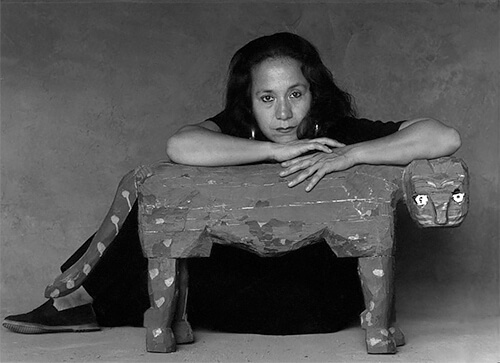Flor Garduño was born in Mexico and studied visual arts at the Academy of San Carlos (UNAM), where she focused on the search for the structural aspects of form and space. She became especially interested in the work of Kati Horna, a Hungarian photographer whose communicative dimension of her photographs had a great impact on the development of Garduño's aesthetic. She gave up her studies to work as a darkroom assistant for Manuel Álvarez Bravo, one of Mexico's most prestigious photographers, with whom she strengthened her photographic skills. Since then, Garduño has received numerable prizes, and her work has been exposed and published around the world. Garduño's photos depict the landscapes of Central and South America -- and the people whose ancestors were indigenous to the region. Her photos depict subjects that could have existed in a time long before the present moment, and through photographing them, brings the Indian land of America to the present moment. She addresses time -- past, present, and future -- simultaneously through her photographs. Through her photos we witness the slow procession from life to death, interrupted by comic accidents, childish play, liturgical ceremonies, and erotic repose. Though many themes traverse Garduño's body of work, all ultimately reach the point of incense where, uncertainly, nature, and art blend so that mankind may have a margin of whimsy, freedom, or significance on the face of the gods.
Source: Peter Fetterman Gallery
Flor Garduño (Born Mexico City, Mexico, 1957) studied at the Escuela Nacional de Artes Plásticas in Mexico City. In 1979 she became an assistant to Manuel Alvarez Bravo. Between 1981 and 1982 she traveled with a team of photographers organized by Mariana Yampolsky. The team photographed rural villages throughout Mexico for reading primers published by the Secretariat of Education for Indigenous Communities. This experience as well as her association with Kati Horn influenced Garduño's photographs, which are usually of country locales and towns depicted in strange and mysterious ways typical of Surrealism in Mexican photography. Garduño had her first one-person exhibition in 1982 at the Galeria Jose Clemente Orozco in Mexico City. In 1985, a compendium of six years of her work was published entitled "Magia del Juego Eterno" and in 1987 another book entitled "Bestiarium" was published. In 1986 she participated in the first photographic exhibition of the Salón de la Plástica Mexicana and in the inauguration of the Kahlo-Coronel Gallery in Mexico City. In 1986 and 1988 she was included in several traveling exhibitions "Reserved for Export" and "Realidades Mágicas" that were seen in the United States and Europe. 1996 Image and Memory, Latin american Photography, 1880-1992 Itinerary: El Museo del Barrio, New York. Art Gallery of the University of Scranton, PA. Lowe Art Museum, Florida. Museo de Arte de Ponce, Puerto Rico. Crocker Art Museum, CA. Meadows Museum, Tx. Akron Art Museum, OH.
Her one-person shows were in Paris in 1986, the Museum Volkenkunde de Rotterdam in 1989, the Field Museum of Chicago in 1990 and Montreal in 1991. Since 1989 she has dedicated herself to photographing the images that appear in her one-person exhibition and monograph, "Witnesses of Time". The exhibition started at the Americas Society in 1993 and will be traveling across the country to the Museum of Photographic Arts in California as well as various other venues. Her work is in the collections of the Museum of Modern Art, New York; Bibliotheque Nationale, Paris; and Centro Cultural de Arte Contemporáneo, Mexico.
Source: Throckmorton Fine Art
Galleries in the USA:
